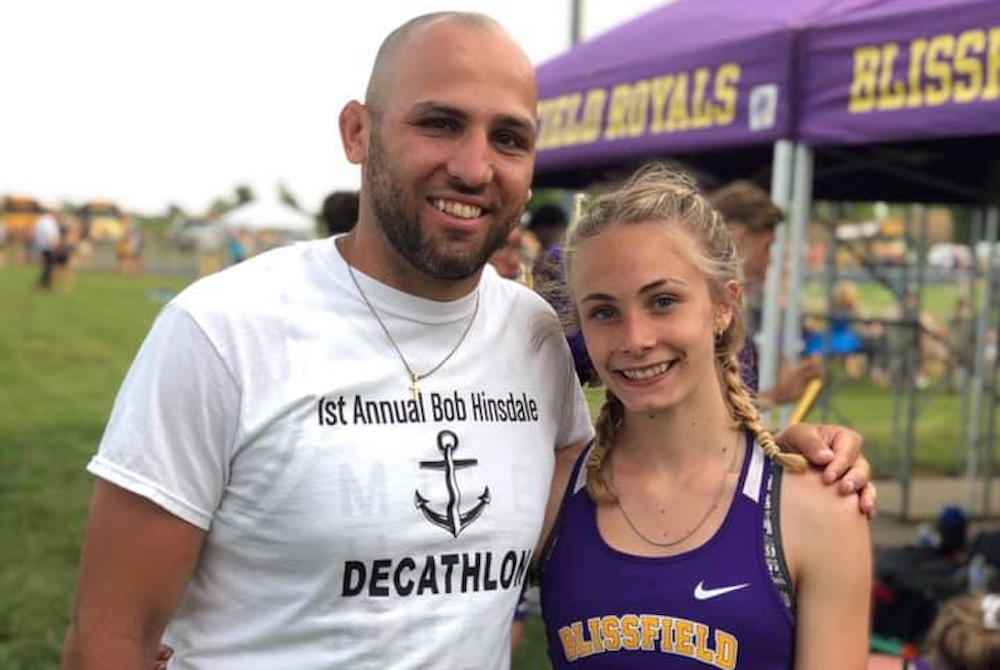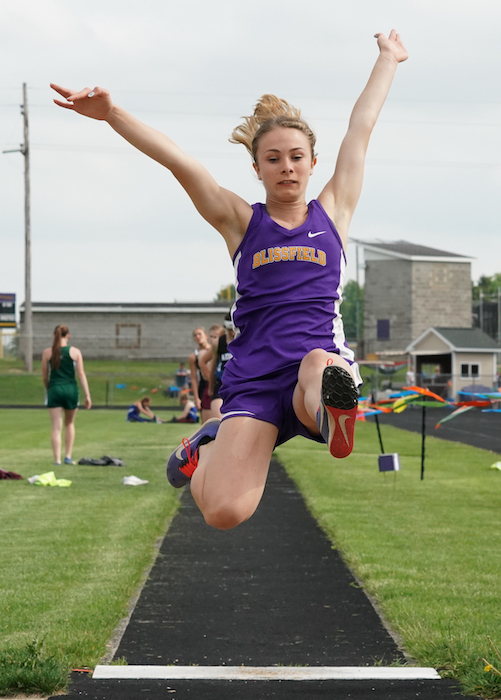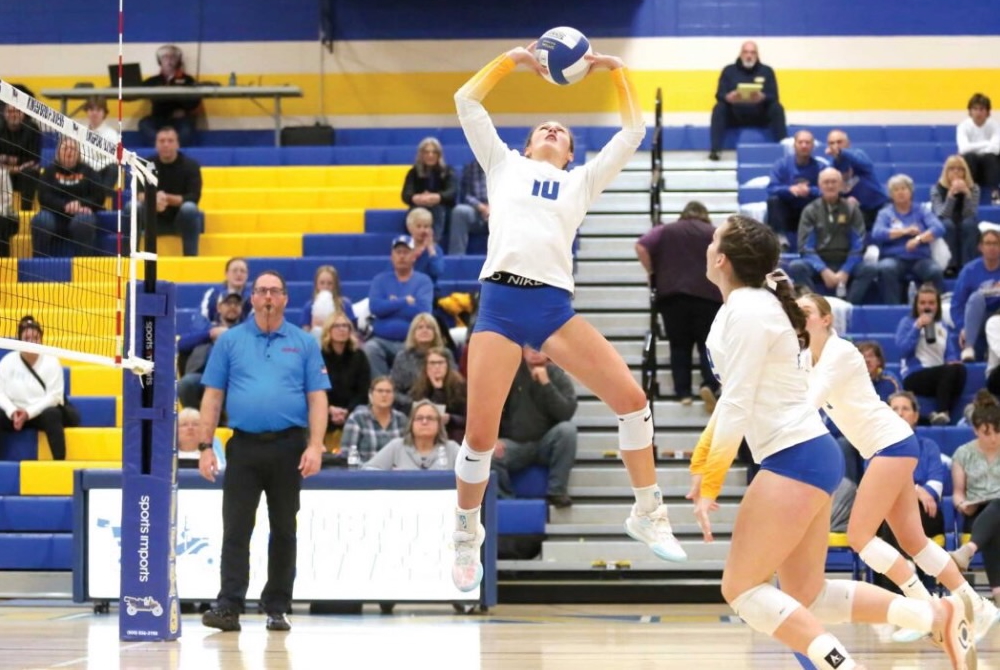
Blissfield's Smith Aims to Spring into More Long-Jumping Success
By
Doug Donnelly
Special for MHSAA.com
March 30, 2022
BLISSFIELD – The 2021 track & field season didn’t start the way Annabelle Smith had hoped, but it sure finished the way she wanted.
 Smith opened the season by long jumping only 15 feet, 5 inches, well short of her best. She bounced back quickly and never lost in the event again, culminating with a Lower Peninsula Division 3 championship in the event.
Smith opened the season by long jumping only 15 feet, 5 inches, well short of her best. She bounced back quickly and never lost in the event again, culminating with a Lower Peninsula Division 3 championship in the event.
“I think it was probably my worst day since middle school,” she said of last spring’s start.
Those days are long behind her. As she prepares for her senior season, she is confident, mentally strong, and physically ready to beat the early spring Michigan weather.
“It’s sort of hard for me because I much prefer warmer weather,” the Blissfield senior said. “Spring is my time to prepare. I try to give as much as I can.”
Michigan’s weather doesn’t do prep athletes any favors this time of the year. But, Smith said, it’s something you have to set aside and push through. It’s part of being mentally strong and focused.
“It’s something you can’t really control. You just have to deal with it.”
Smith picked up track & field in middle school. Her coaches had all of the athletes try every event to see what they were best at. She immediately took to the long jump. She qualified for the Finals as a freshman and tied for eighth place in the long jump but missed out on being named all-state due to a tiebreaker.
She trained hard for her sophomore year, only to have it canceled due to COVID-19. Last year she recovered from that early-season meet to win the Lenawee County championship, Lenawee County Athletic Association championship, Regional and Finals titles. She set a personal record at the LPD3 Finals meet with a jump of 18-1.5 and became Blissfield’s first female athlete to win a state track title in 30 years.
“What sets her apart is her competitiveness and ability to adapt in any situation,” said Calvin Sullins, a former decathlete at Siena Heights University who now coaches Smith at Blissfield. “She trusts our process and is an exceptional student of the sport.”
There was a time that Smith just went out, located her marks, and jumped.
 Sullins and the rest of the Royals coaching staff turned her head by concentrating on technique.
Sullins and the rest of the Royals coaching staff turned her head by concentrating on technique.
“Coach Sullins has a lot of knowledge about track in general,” she said. “It’s been great to work with him. Being a decathlete, he knows about every event.”
One of the techniques she learned was to count steps rather than just look for her mark when starting to sprint as she approaches the long jump platform.
“I use an 11-step approach,” she said. “I count 11 strides, and I lift off.”
She counts down in her head every time her left foot hits the ground.
“I jump when I’m at one,” she said. “I don’t have to worry where I’m at. It took a little bit to get used to, but it makes everything easier.”
She has scratched on occasion, but she trusts in her ability to take equal strides and count the 11 steps during her approach.
Being consistent in her events is her biggest challenge. She also takes pride in her mental approach to every event. There can be long breaks during a track meet, but she makes sure to get focused when she has to.
“Mentally, I’ve changed a lot,” she said. “For me, what works is to be very involved with the team and not spend my down time thinking about my event. When I start to warm up, I just envision what my jumps are going to look like. That’s my time to myself, my time to get focused.”
In between her junior and senior year of high school, she competed in a United States Track and Field Junior Olympic event in Atlanta, placing third in her division. She also had a national event in Florida. Closer to home, she entered some indoor meets in the open class in the area and trained whenever she found the opportunity to get out of the cold.
“I just tried to stay consistent all winter,” she said. “For me, technique is very important.”
Smith is looking at a few colleges, some nearby and some across the country. She’s undecided what she wants to do or where she wants to compete at the next level.
This year she intends to compete in the 100 or 200 meters and possibly some relays as well as the long jump. Her goal is to start stronger than last year and steadily improve as the season goes on and be at her best come the first weekend in June – when the MHSAA Finals take place.
“This year, my goal is to PR and get back to the state meet and place,” she said. “I have a lot of time to improve myself. That’s my main goal – to be better.”
 Doug Donnelly has served as a sports and news reporter and city editor over 25 years, writing for the Daily Chief-Union in Upper Sandusky, Ohio from 1992-1995, the Monroe Evening News from 1995-2012 and the Adrian Daily Telegram since 2013. He's also written a book on high school basketball in Monroe County and compiles record books for various schools in southeast Michigan. E-mail him at [email protected] with story ideas for Jackson, Washtenaw, Hillsdale, Lenawee and Monroe counties.
Doug Donnelly has served as a sports and news reporter and city editor over 25 years, writing for the Daily Chief-Union in Upper Sandusky, Ohio from 1992-1995, the Monroe Evening News from 1995-2012 and the Adrian Daily Telegram since 2013. He's also written a book on high school basketball in Monroe County and compiles record books for various schools in southeast Michigan. E-mail him at [email protected] with story ideas for Jackson, Washtenaw, Hillsdale, Lenawee and Monroe counties.
PHOTOS (Top) Annabelle Smith, right, and credits her Blissfield coach Calvin Sullins with helping her become a championship long jumper. (Middle) Smith jumps during the 2019 Lenawee County Championships. (Top photo courtesy of the Smith family; middle photo by Mike Dickie.)

Kingsford's Kreider Prepared for Next Level After Finishing Stellar Flivvers Career
By
John Vrancic
Special for MHSAA.com
June 19, 2025
KINGSFORD — After completing a successful high school volleyball career, Maddy Kreider is ready to take the next step.
 The Kingsford senior is taking her talents to Michigan Tech, where she’s expected to continue primarily as a setter.
The Kingsford senior is taking her talents to Michigan Tech, where she’s expected to continue primarily as a setter.
“That will be a big step for sure, but it’ll be exciting being with the girls,” she said. “The girls are taller in college. It will definitely be an adjustment, physically and mentally. We’ll be traveling longer distances, and it’ll be a matter of improving the mental part of my game.”
Kreider was selected the Upper Peninsula’s Defensive Player of the Year her final two seasons after the U.P. Sportswriters and Sportscasters Association began voting for all-U.P. volleyball.
“That’s quite an accomplishment,” she said. “It’s a real honor playing with girls I grew up with. We had a great season.”
The 5-foot-8 setter was a four-year starter and two-year team captain at Kingsford, leading the Flivvers to three Division 2 District titles and back-to-back undefeated Great Northern Conference championships. She twice was named GNC Player of the Year.
She was also selected all-state first team in the fall and all-state second team in 2023, and all-region throughout her prep career. Her serving percentage also topped .900 throughout her four seasons on varsity.
 Last fall, the Flivvers reached the Regional Semifinal at Manistique where they dropped a 3-2 decision to Kingsley.
Last fall, the Flivvers reached the Regional Semifinal at Manistique where they dropped a 3-2 decision to Kingsley.
“I thought we’d get through,” Kreider said. “We came out lights out in the first two sets, then it was close in the last three.”
Also among the team’s highlights this past fall was a victory at Calumet, approximately 2½ weeks after dropping a 3-1 decision to the Copper Kings on Kingsford’s home floor.
“We wanted to play them,” Kreider said. “They’re a great bunch of girls to play against. They’ve been the measuring stick up here for many years. Winning on their floor was super exciting. We knew we had to play well just to be competitive. That was a great confidence builder for our group. We were definitely on a high going into the District.”
The Flivvers opened their postseason with a 3-1 triumph over Houghton, then defeated Escanaba in straight sets in the District Final.
Kreider will join Calumet senior Maddie Torola at MTU this fall. Torola, who recorded a season-high 19 kills in the four-set victory at Kingsford, helped the Copper Kings finish 29-5 and reach the Division 3 Regional Final at Sault Ste. Marie where they dropped a 3-2 decision to Traverse City St. Francis.
“It was fun playing against her in high school,” Kreider said. “It will be even more fun playing as teammates. It’ll be exciting to be playing on the same team.”
Both will be playing under new head coach Cindy Pindral at Tech. Both of Kreider’s parents played for the Huskies, her mother (and Kingsford varsity coach) Jaclynn volleyball from 1998-2002 and her father Jason basketball from 1997-2000.
Maddy Kreider recently earned an additional honor when she was selected Female Athlete of the Year for Kingsford’s Class of 2025. She recently completed a solid track & field season for the Flivvers.
At the U.P. Division 1 Finals, Kreider placed fourth in the 100-meter dash (13.2) and anchored the Flivvers to a third-place finish in the 800 relay (1:51.57) and fourth in the 400 (53.03) on their home track.
Kreider was named one of 32 MHSAA/Farm Bureau Insurance Scholar-Athlete Award winners this winter and plans to study exercise science and kinesiology at MTU.
 John Vrancic has covered high school sports in the Upper Peninsula since joining the Escanaba Daily Press staff in 1985. He is known most prominently across the peninsula for his extensive coverage of cross country and track & field that frequently appears in newspapers from the Wisconsin border to Lake Huron. He received the James Trethewey Award for Distinguished Service in 2015 from the Upper Peninsula Sportswriters and Sportscasters Association.
John Vrancic has covered high school sports in the Upper Peninsula since joining the Escanaba Daily Press staff in 1985. He is known most prominently across the peninsula for his extensive coverage of cross country and track & field that frequently appears in newspapers from the Wisconsin border to Lake Huron. He received the James Trethewey Award for Distinguished Service in 2015 from the Upper Peninsula Sportswriters and Sportscasters Association.
PHOTOS (Top) Kingsford’s Maddy Kreider sets for her teammates during a match last season. (Middle) Kreider, right, takes a photo with Kingsford’s Male Athlete of the Year Gavin Grondin. (Photos provided by the Kingsford athletic department.)

